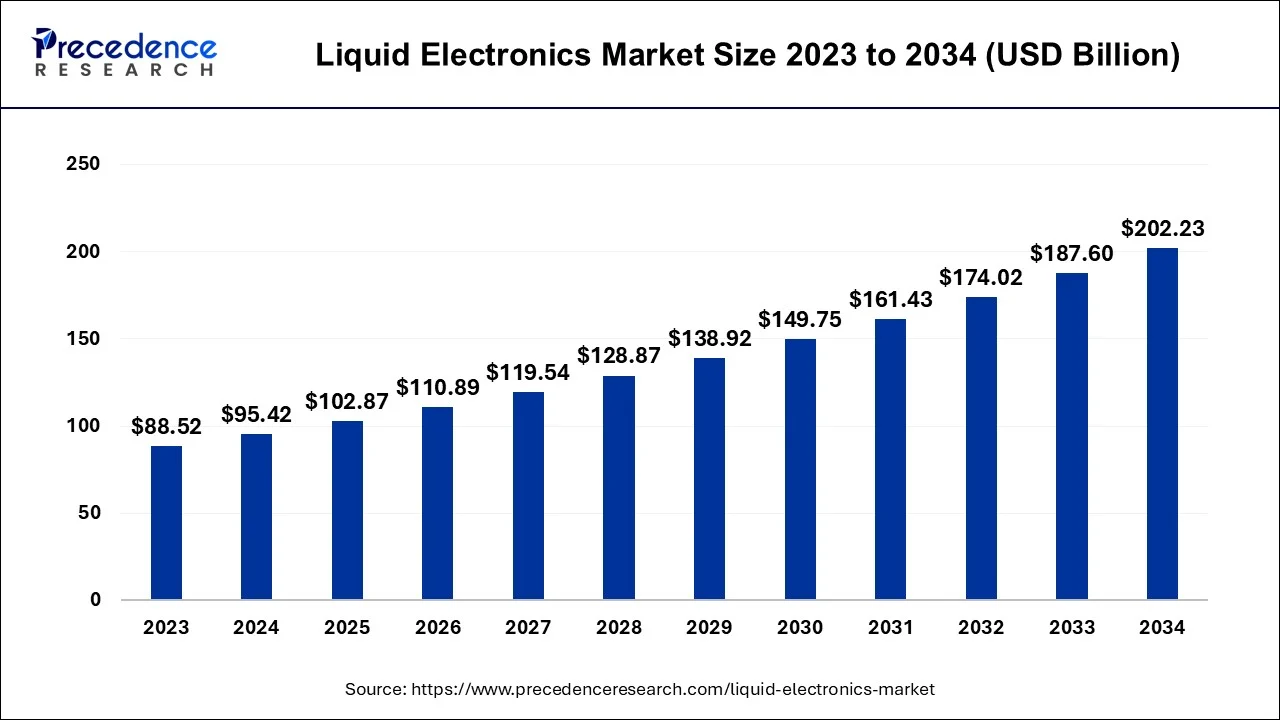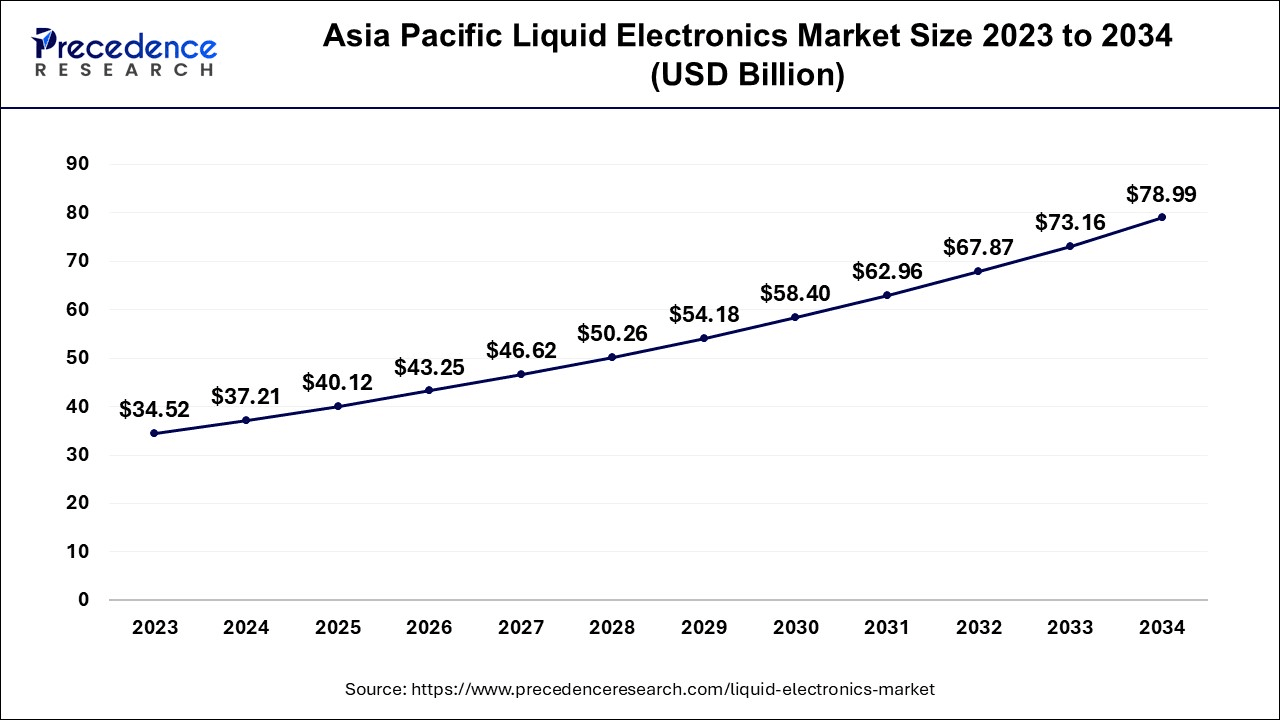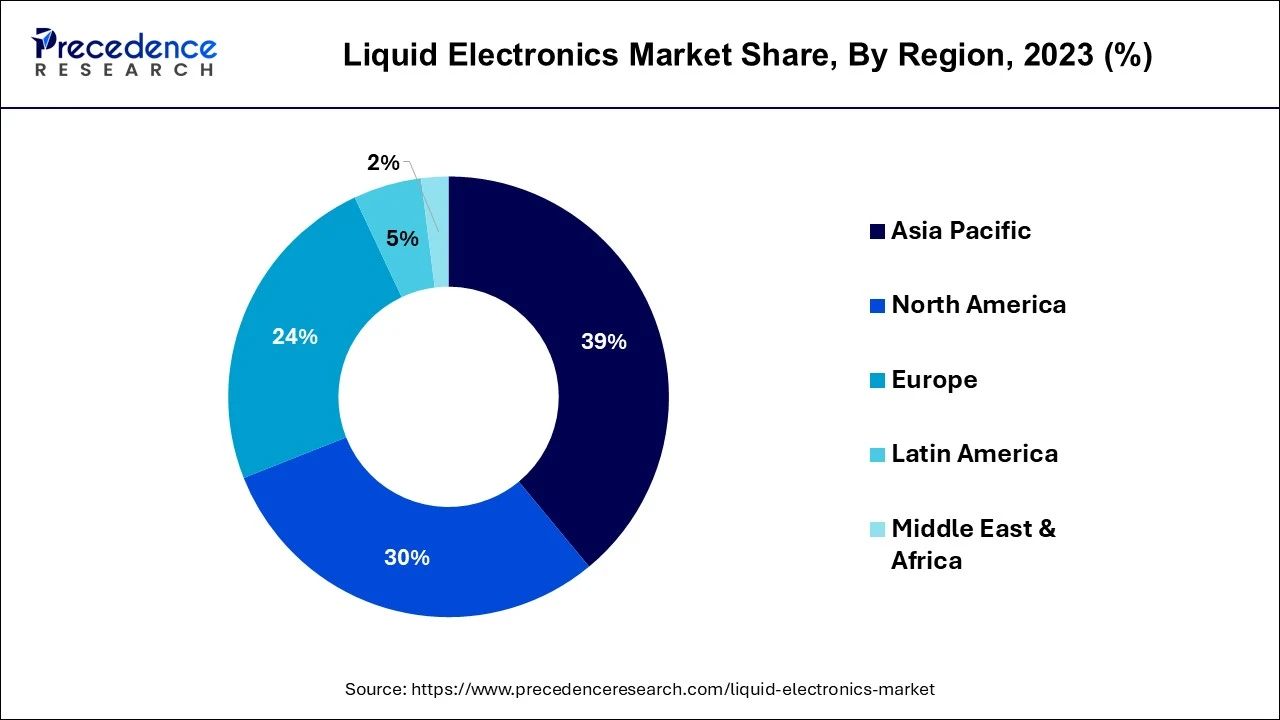What is the Liquid Electronics Market Size?
The global liquid electronics market size accounted for USD 102.87 billion in 2025, grew to USD 110.89 billion in 2026 and is anticipated to reach around USD 202.23 billion by 2035, growing at a CAGR of 6.99% between 2026 and 2035.

Liquid Electronics Market Key Takeaways
- Asia Pacific contributed more than 39% of revenue share in 2025.
- LAMEA region is estimated to expand the fastest CAGR between 2026 and 2035.
- By type, the conductive liquids segment has held the largest market share of 38% in 2025.
- By type, the semiconductor liquids segment is anticipated to grow at a remarkable CAGR of 8.1% between 2026 and 2035.
- By application, the flexible electronics segment generated over 43% of revenue share in 2025.
- By application, the wearable electronics segment is expected to expand at the fastest CAGR over the projected period.
- By end-user, the consumer electronics segment had the largest market share of 54% in 2025.
- By end-user, the automotive segment is expected to expand at the fastest CAGR over the projected period.
Market Overview
The liquid electronics market encompasses a diverse range of electronic components and materials in liquid form. It includes conductive, dielectric, and semiconductor liquids, each tailored for specific applications. Liquid electronics find their place in flexible and wearable electronics, printed electronics, energy storage, displays, sensors, and lighting.
The liquid electronics market serves various industries, including consumer electronics, healthcare, automotive, aerospace, industrial and manufacturing, energy, retail, telecommunications, and environmental monitoring. The demand for adaptable and flexible electronic solutions propels its growth. As technology progresses, the liquid electronics market continually evolves, ushering in fresh opportunities for the design and production of electronic devices.
Liquid Electronics Market Growth Factors
- The surging demand for bendable and stretchable electronic components in applications such as wearables and flexible displays is a significant growth driver.
- Advanced manufacturing techniques like 3D printing and inkjet printing are transforming electronic production processes, offering scalability and cost-efficiency.
- Liquid electronics play a pivotal role in advanced battery technologies, supporting renewable energy integration and the proliferation of electric vehicles.
- A shift towards OLED and E-ink displays for enhanced energy efficiency, superior visuals, and innovative user experiences is driving growth.
- Liquid-based sensors are increasingly being adopted in critical areas like healthcare, automotive safety, and environmental monitoring, propelling their demand.
- Offering tailored liquid electronic solutions for niche markets and unique applications to meet specialized requirements.
- Investing in continuous research and development efforts focused on innovative materials and technologies is essential for staying competitive and ahead of industry trends.
- Collaborating with research institutions and technology companies can lead to breakthrough innovations and shared resources for advancing the field.
Liquid Electronics Market Scope
| Report Coverage | Details |
| Growth Rate from 2026 to 2035 | CAGR of 6.99% |
| Market Size in 2025 | USD 102.87 Billion |
| Market Size 2026 | USD 110.89 Billion |
| Market Size by 2035 | USD 202.23 Billion |
| Largest Market | Asia Pacific |
| Base Year | 2025 |
| Forecast Period | 2026 to 2035 |
| Segments Covered | Type, Application, End Use, and Region |
| Regions Covered | North America, Europe, Asia-Pacific, Latin America, and Middle East & Africa |
Market Dynamics
Driver
Printed, flexible, and wearable electronics
Printed, flexible, and wearable electronics have become prominent catalysts for the burgeoning demand in the liquid electronics market. These innovations are reshaping the industry by offering groundbreaking advantages in terms of design flexibility, portability, and adaptability. Printed electronics, driven by advancements in conductive inks and additive manufacturing techniques, have revolutionized production processes.
These approaches facilitate cost-efficient, scalable, and adaptable production of electronic components. The capability to print electronic circuits and sensors onto a wide range of substrates paves the way for their deployment in a multitude of industries. This extends from healthcare to automotive, heralding a fresh era of versatile electronic devices.
Flexible and wearable electronics, on the other hand, are meeting the rising consumer demand for adaptable and lightweight technology solutions. These innovations allow for electronics to be seamlessly integrated into clothing, and accessories, or worn directly on the body. With liquid components, these devices can be more malleable, offering consumers comfortable and unobtrusive options. This surge in demand is pushing manufacturers to explore liquid materials that can deliver both high performance and durability while conforming to various shapes and sizes. The combination of printed, flexible, and wearable electronics is therefore driving the liquid electronics market to new heights, fueling innovation, and offering consumers more convenient and versatile electronic solutions.
Restraint
Material compatibility issues and lack of industry standards
Material compatibility issues pose a substantial obstacle as various liquid materials and substrates used in the manufacturing process may not interact optimally. This leads to concerns regarding the reliability and performance of electronic components. Ensuring that conductive, dielectric, and semiconductor liquids work effectively together, and with other materials, demands extensive research and development efforts. These challenges can result in longer development cycles and increased costs, ultimately deterring potential adopters of liquid electronics.
The absence of industry standards further exacerbates these challenges. Without established norms and guidelines, manufacturers face difficulties in ensuring consistency and interoperability across different liquid electronics products. This uncertainty hampers market growth as potential customers are often hesitant to invest in solutions that may not seamlessly integrate with existing systems or adhere to industry-specific regulations. To overcome these constraints, industry players must collaborate to establish standardized testing and manufacturing practices, fostering a more conducive environment for liquid electronics adoption and market expansion.
Opportunity
Custom electronics solutions and collaborative partnerships
Customization in the liquid electronics market is a potent catalyst for increased market demand. As industries seek specialized solutions to address unique challenges and applications, the ability to tailor liquid electronic components becomes crucial. Customization enables businesses to provide precise electronic solutions that meet specific requirements, ensuring optimal performance and functionality.
For example, by offering customized liquid-based sensors for a range of applications, manufacturers can effectively address diverse industries, from healthcare to aerospace, further expanding their market reach. Customization also allows companies to create niche products, tapping into previously unexplored markets and fostering brand differentiation.
Collaborative partnerships in the liquid electronics sector play a pivotal role in surging market demand. Technology companies, research institutions, and manufacturers often join forces to pool resources, share knowledge, and drive innovation. By working together, these entities can leverage collective expertise and accelerate the development of new liquid electronic technologies and applications. Collaborative efforts also enable the exploration of uncharted territories, making it possible to identify and seize opportunities that may not be attainable through individual efforts. This fosters a culture of innovation, leading to the introduction of cutting-edge liquid electronic solutions, expanding market demand, and keeping the industry dynamic and responsive to evolving customer needs.
Segment Insights
Type Insights
According to the type, the conductive liquids segment held 38% revenue share in 2023. Conductive liquids are materials with the ability to carry electrical current. In the liquid electronics market, these liquids, often containing metallic or conductive particles, serve as essential components in flexible circuits, printed electronics, and sensors. Recent trends show a growing demand for conductive inks and polymers, especially in applications like wearable technology, flexible displays, and smart packaging. The need for lightweight, highly flexible, and electrically conductive materials drives research and innovation in this segment, pushing for improvements in conductivity, adhesion, and environmental sustainability.
The semiconductor liquids segment is anticipated to expand at a significant CAGR of 8.1% during the projected period. Semiconductor liquids are materials that exhibit semiconductor properties when in a liquid state. They play a crucial role in various liquid electronics applications, including organic photovoltaics, organic light-emitting diodes (OLEDs), and flexible electronic devices. The liquid electronics market is witnessing trends toward developing semiconductor liquids with enhanced electrical performance and stability. These innovations aim to create more efficient and reliable electronic components, opening up opportunities for energy-efficient displays and high-performance flexible electronics in a rapidly evolving industry.
Application Insights
Based on the application, the flexible electronics segment is anticipated to hold the largest market share of 43% in 2023. Flexible electronics involve the use of liquid materials and technologies that allow electronic components to bend, twist, and stretch. This application segment is a key trend in the liquid electronics market, driven by consumer demand for adaptable and durable devices. Trends in flexible electronics include the development of rollable displays, foldable smartphones, and wearable sensors for healthcare and fitness applications. These advancements open new avenues for innovation in areas such as consumer electronics and medical devices, potentially revolutionizing device design and user experiences.
On the other hand, the wearable electronics segment is projected to grow at the fastest rate over the projected period. Wearable electronics are electronic devices integrated into clothing, accessories, or worn on the body. Liquid electronics are instrumental in developing flexible, comfortable, and lightweight wearable gadgets. The market trend for wearable electronics focuses on improving health monitoring, fitness tracking, and seamless connectivity. Liquid-based sensors for vital signs and biometric data are enhancing user experiences and enabling the integration of IoT capabilities. These trends reflect a growing interest in convenient, discreet technology solutions that cater to consumers' active lifestyles.
End-user Insights
In 2023, the consumer electronics segment had the highest market share of 54% based on the end user. In the liquid electronics market, consumer electronics refers to devices designed for personal use. This segment includes smartphones, tablets, smartwatches, and other portable gadgets. A significant trend in this segment involves the integration of flexible and bendable displays and components, offering improved durability and adaptability. Moreover, the adoption of energy-efficient liquid-based technologies, like OLEDs, enhances the visual quality of consumer electronic devices, while contributing to longer battery life and thinner profiles.
The automotive segment is anticipated to expand at the fastest rate over the projected period. In the automotive sector, liquid electronics pertain to electronic components and materials used in vehicles. A notable trend is the incorporation of liquid-based sensors and displays for advanced driver-assistance systems (ADAS), infotainment, and interior lighting. This trend enhances safety, convenience, and the overall driving experience, as automotive manufacturers seek innovative ways to make vehicles more connected and intelligent.
Regional Insights
What is the Asia Pacific Liquid Electronics Market Size?
The Asia Pacific liquid electronics market size is estimated at USD 40.12billion in 2025 and is expected to be worth around USD 78.99 billion by 2035, poised to grow at a CAGR of 7.01% from 2026 to 2035.

Asia Pacific has held the largest revenue share at 39% in 2023. Asia Pacific is a burgeoning powerhouse in the liquid electronics market, driven by a thriving consumer electronics industry. The adoption of liquid-based sensors, flexible displays, and wearable devices is on the rise. Asia Pacific leads in manufacturing, offering cost-effective solutions and mass production capabilities. With a growing emphasis on miniaturization, IoT integration, and sustainability, the region is at the forefront of innovation. Collaborative efforts and research and development initiatives are rapidly accelerating liquid electronics' market penetration and spurring significant growth in the region.
India Liquid Electronics Market Analysis
India's market is growing due to rising demand for flexible, wearable, and printed electronic devices across various sectors, including healthcare and automotive. Increasing investments in R&D, expanding manufacturing capabilities, government support for technological innovation, and growing adoption of IoT and miniaturized electronics are further driving market expansion.

What Drives the Market in North America?
In North America, the liquid electronics market is experiencing robust growth, driven by increasing investments in research and development. The region is witnessing a surge in demand for flexible and printed electronics, with applications in consumer electronics, healthcare, and automotive sectors. Moreover, a focus on sustainability and eco-friendly materials is becoming prominent, aligning with the region's environmental goals. Collaborative partnerships with research institutions and technology companies are fostering innovation and expanding market reach, solidifying North America's position as a key hub for liquid electronics development.
U.S. Liquid Electronics Market Analysis
The U.S. market is growing due to strong R&D investments, technological advancements in flexible, printed, and wearable electronics, and growing applications in healthcare, consumer devices, and automotive sectors. Focus on sustainability, adoption of eco-friendly materials, and collaborations between tech companies and research institutions further drive innovation and expand market penetration across North America.
How is the Opportunistic Rise of Latin America in the Liquid Electronics Market?
Latin America is experiencing an opportunistic rise in the market due to growing demand for advanced consumer electronics, flexible displays, and wearable devices. Increasing investments in research and development, local manufacturing capabilities, and strategic partnerships with global electronics players are accelerating market growth. Additionally, rising smartphone adoption, e-commerce expansion, and the push for innovative, lightweight, and flexible electronic solutions are creating strong opportunities in the region.
Brazil Liquid Electronics Market Analysis
Brazil's market is expanding as local manufacturers adopt advanced materials and production techniques for cost-effective, scalable solutions. Rising urbanization, smart device penetration, and interest in eco-friendly electronics, combined with collaborations between startups and international technology companies, are driving innovation and increasing market adoption across various industrial and consumer applications.
Value Chain Analysis
- Raw Material & Component Sourcing
This stage involves sourcing conductive inks, liquid metals like gallium alloys, substrates, and polymers required for liquid electronics devices.
Key Players: Sigma-Aldrich, 3M, and DuPont. - Device Manufacturing
In this stage, raw materials and technologies are transformed into functional liquid electronics devices, including flexible displays, wearable sensors, and soft robotics components.
Key Players: MC10, Sun Innovations, and Electroninks. - Distribution & System Integration
This stage involves supplying devices to OEMs, consumer electronics brands, healthcare companies, and industrial manufacturers.
Key Players: MC10, Electroninks, and Sun Innovations.
Liquid Electronics Market Companies
- Sony Corporation: Develops flexible and printed electronics for displays, sensors, and wearable devices, focusing on consumer electronics and advanced imaging solutions.
- E Ink Holdings, Inc.: Specializes in e-paper and electrophoretic displays, providing low-power, flexible, and high-contrast solutions for e-readers, signage, and wearable electronics.
- DuPont de Nemours, Inc.: Offers conductive inks, coatings, and dielectric materials for printed electronics, flexible circuits, and wearable electronic applications.
- Panasonic Corporation: Provides liquid crystal technologies, flexible displays, and sensors for consumer electronics, automotive, and industrial applications.
- Dupont Displays, Inc.: Supplies advanced materials for OLEDs, flexible displays, and liquid electronics, enhancing performance, durability, and design versatility.
- Kent Displays, Inc.: Focuses on electrochromic and flexible display technologies, offering innovative liquid crystal solutions for smart devices and educational tools.
- Novaled GmbH: Develops OLED materials and technologies for high-performance flexible and printed electronics, enabling energy-efficient displays and wearable applications.
Other Major Key Players
- Samsung Group
- LG Display Co., Ltd.
- Liquid X Printed Metals, Inc.
- The Dow Chemical Company
- Neotech AMT GmbH
- Molex, LLC
- BASF SE
- TDK Corporation
Recent Developments
- In November 2025, nVent Electric plc (NYSE: NVT) announced modular liquid cooling solutions for data centers, designed to meet current and future chip cooling needs. The offerings include enhanced row- and rack-based coolant distribution units (CDUs) and advanced cooling system manifolds.
(Source: https://investors.nvent.com/) - In August 2024, JSR Corporation acquired all shares of Yamanaka Hutech Corporation, making it a wholly owned subsidiary. The acquisition strengthens JSR's semiconductor materials portfolio, especially in film-forming technologies, supporting its growth strategy to enhance customer value and optimize the supply chain in the evolving semiconductor industry.(Source: https://www.jsr.co.jp/)
- In May 2024, Air Liquide opened a new diborane production facility at its Advanced Materials Center in Sejong, South Korea. Using advanced digital and analytical technologies, the plant supplies high-quality diborane for semiconductor manufacturing, supporting Korea's semiconductor ecosystem and Air Liquide's strategy to localize advanced material production.(Source: https://electronics.airliquide.com/)
- In 2022, DYNICS, a provider of industrial hardware and software, established a system integrator partnership with SINCI, a leading Mexican technology organization. This collaboration will deliver automation tools, benefiting customers in various industries and facilitating digital transformation.
- In 2022,Henkel inaugurated an Application Center in Santa Clara, CA, to aid product development for tech customers in Silicon Valley. This cutting-edge facility accelerates proof-of-concept projects for electronics innovations.
- In 2022,Parker Hannifin has broadened its product range for electric vehicle manufacturers with the introduction of Thermally Conductive adhesives and low-density gap fillers. These additions complement their thermal management encapsulants, adhesives, and gap fillers, enhancing their product offerings.
- In 2022,Rockwell Automation Inc. has agreed to acquire CUBIC, a modular electrical panel systems specialist. This collaboration aims to expedite time to market, broaden intelligent motor control applications, and enhance sustainability and productivity for diverse customers.
Segments Covered in the Report
By Type
- Conductive Liquids
- Dielectric Liquids
- Semiconductor Liquids
- Functional Liquids
By Application
- Flexible Electronics
- Wearable Electronics
- Printed Electronics
- Energy Storage
- Displays
- Sensors
- Lighting
- Others
By End Use
- Consumer Electronics
- Healthcare
- Automotive
- Aerospace and Defense
- Industrial and Manufacturing
- Energy and Power Generation
- Retail and Advertising
- Telecommunications
- Others
By Geography
- North America
- Europe
- Asia-Pacific
- Latin America
- Middle East and Africa
For inquiries regarding discounts, bulk purchases, or customization requests, please contact us at sales@precedenceresearch.com
Frequently Asked Questions
Tags
Ask For Sample
No cookie-cutter, only authentic analysis – take the 1st step to become a Precedence Research client




 sales@precedenceresearch.com
sales@precedenceresearch.com
 +1 804-441-9344
+1 804-441-9344